Speech Changing Relative Prices and the Structure of the Australian Economy

Philip Lowe
Assistant Governor (Economic)
Address to the Australian Industry Group 11th Annual Economic Forum
Sydney –
- Audio 16.15MB
Thank you for the invitation to speak again at the Australian Industry Group's Annual Economic Forum. Over many years, Ai Group and its members have provided the Reserve Bank of Australia with valuable insight into the issues affecting firms and so it is a pleasure to be here this morning.
The topic I would like to talk about is structural change in the Australian economy. For the Reserve Bank, understanding the various shifts that are going on in the industrial structure of the country is important. It is also obviously important for the firms that are living through these changes and having to respond to them on a daily basis.
I would like to focus on two aspects of the changes that are taking place.
The first is the movement in relative prices that is occurring within the economy. The most obvious relative price that has shifted – and the one we have spoken most about – is the price of Australia's exports relative to the price of our imports – what economists call the ‘terms of trade’. With commodity prices having increased very substantially since the early 2000s, Australia's terms of trade are currently around their highest level on record and around 90 per cent above their average level for the 1990s (Graph 1). But there are many other relative prices that are changing as well and I would like to touch on some of these this morning.
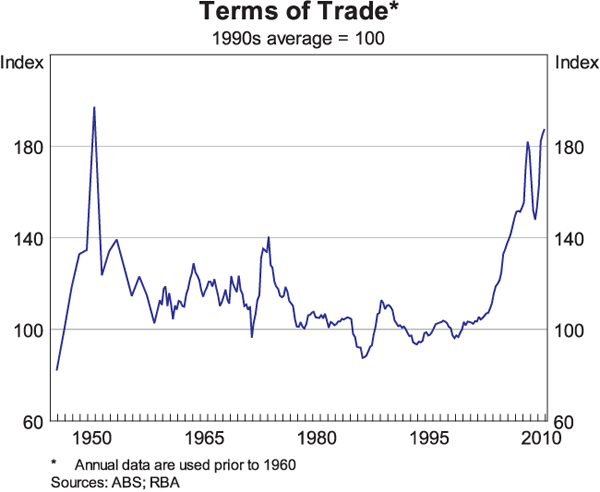
The second, and obviously related, issue is how these changes in relative prices are affecting the current structure of the economy, and in particular how labour and capital are being allocated across different industries.
Changing Relative Prices
There are three broad sets of relative prices that I would like to draw your attention to:
- the price of manufactured goods relative to the price of other goods and services;
- the price of investment goods relative to output prices; and
- the price of labour relative to both the price of output and the price of consumption.
Each of these sets of relative prices has been undergoing quite large changes over recent times, with these changes reflecting the combined effects of high global commodity prices and the associated high level of the exchange rate.
In terms of manufactured goods, it has been common worldwide for their prices to fall over time relative to the price of services. This is the result of faster growth in productivity in manufacturing than in services, as well as globalisation. This long-term trend is clearly evident in the Australian data, but over recent years, as the Australian dollar has appreciated, the decline in the relative retail price of manufactured goods[1] – many of which are imported – has been particularly pronounced (Graph 2). Indeed, over 2010, the difference in the CPI inflation rate for manufactured goods and the CPI inflation rate for other goods and services was larger than it has been at any time over the past two decades.
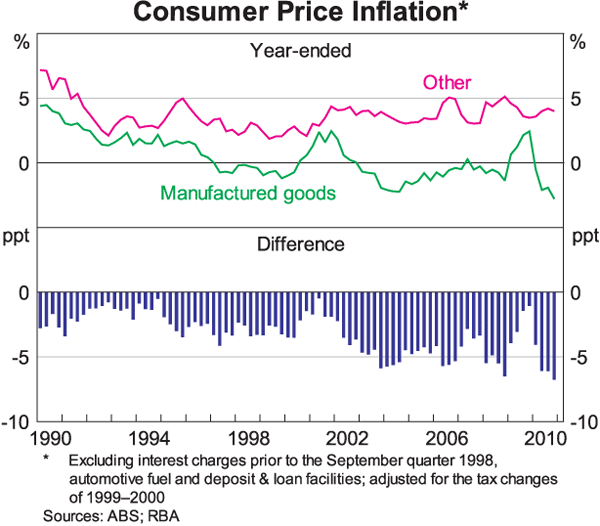
Not unexpectedly, this decline in the relative price of manufactured goods has caught the attention of the household sector. In consumer surveys, the number of people that say now is a good time to buy major household items is around its highest level in more than two decades (Graph 3). But interestingly, households do not appear to have responded particularly strongly to this fall in both the absolute and the relative price of manufactured goods, with retail spending having been quite subdued recently. Many households have preferred to use the growth in their incomes to increase their savings rather than to buy more manufactured goods at lower prices. As the Bank has discussed on a number of occasions recently, whether or not this continues will have a significant bearing on how the economy evolves over the next year or so.
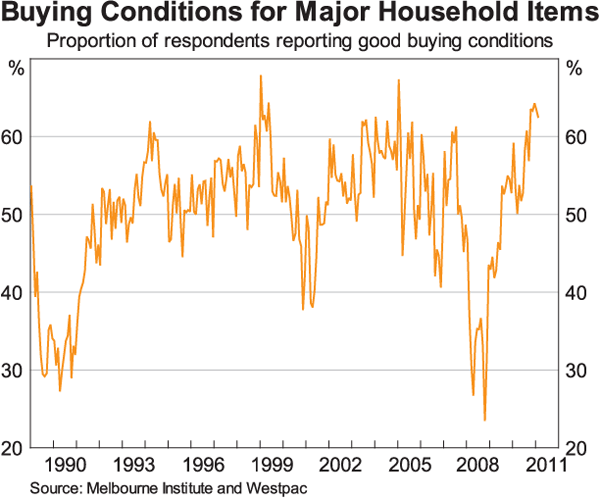
The current large change in relative prices is also making it more difficult for households to assess the rate of overall inflation. This is because when relative consumer prices are moving a lot, the perceived inflation rate depends more than usual on the particular bundle of goods and services that one buys. Over the past year, people whose purchases are more tilted towards goods will have experienced a lower rate of inflation than those whose purchases are tilted towards services and utilities. But, importantly, for the community as a whole, consumer prices have increased by 2.7 per cent over the past year, consistent with the medium-term inflation target.
The second relative price that I mentioned is the price of investment goods relative to the price of output. When the price of machinery and equipment is cyclically low relative to the price of goods and services produced using those investment goods, investment tends to be high. And indeed this is what we have seen over the past 10 years in Australia.
As with the price of manufactured consumer goods, there is a clear downward trend over time in the relative price of machinery and equipment (Graph 4). This is largely, but not solely, driven by technology improvements lowering the price of computing power. But again, just as is the case for consumer goods, the decline in the relative price of machinery and equipment has been unusually large over the past decade. The exchange rate has obviously played an important role here as well. And the lower prices for investment goods have helped make investment more attractive in a number of areas of the Australian economy.
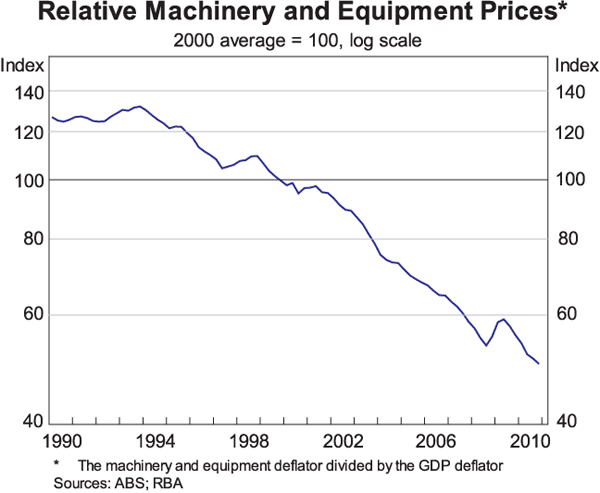
The third set of relative prices that I would like to talk about are those that relate to the price of labour. For workers, what matters is the wage that is received relative to the price of the goods and services that they purchase – the so-called real consumption wage. For firms, what matters is the wage they pay, relative to the price of the goods and services that they sell – the so-called real product wage. Normally, at least at the aggregate level, these two are pretty similar, since there is a close correspondence between the goods and services that people buy and the goods and services that firms produce.
Over recent years, however, this correspondence has broken down as the improvement in the terms of trade has increased the price at which aggregate output is sold relative to the price of consumption (Graph 5). Since 2000, the economy-wide real consumption wage has increased by around 25 per cent, which represents a substantial increase in the purchasing power of the average wage. In contrast, over the same period, the aggregate real producer wage has increased by only around 10 per cent. This relatively modest increase in the cost of hiring labour relative to the price at which aggregate output is sold has helped underpin strong employment growth. It has also contributed to an increase in the aggregate profit share of national output, which is currently around its highest level in the past 50 years (Graph 6). The relatively modest growth in the aggregate producer wage is also consistent with the slowing in aggregate labour productivity growth, as firms have been willing to hire more labour than would otherwise have been the case.
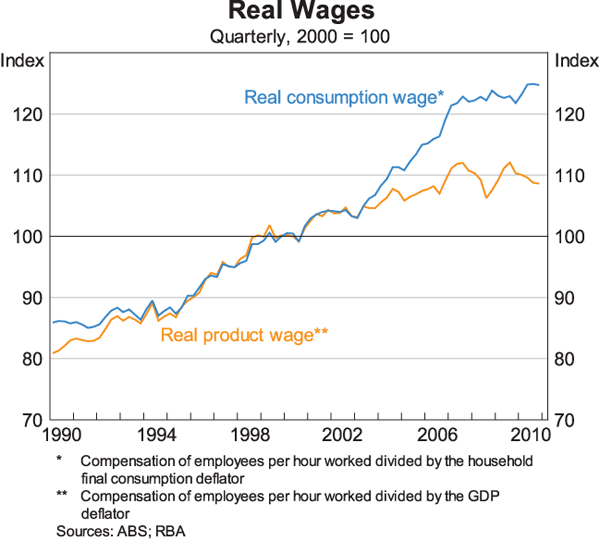
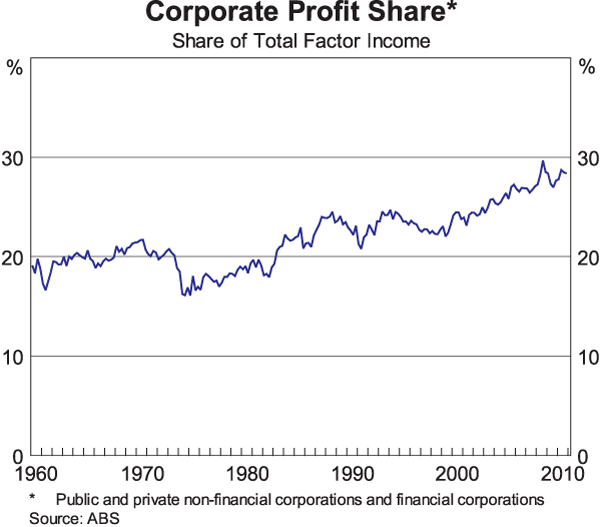
While this aggregate picture is pretty clear, it hides very significant differences across industries (Graph 7). These differences largely arise because of differences in productivity growth across industries as well as movements in world prices. In industries with relatively fast productivity growth, real product wages tend to rise over time, as the productivity growth puts downward pressures on prices relative to wages. This is evident in the increase in real product wages in the manufacturing sector. In contrast, in many service industries, real product wages have moved broadly sideways. In these industries, labour is the main input and measured productivity growth has been slower, so output prices and labour costs have tended to move broadly in line with one another over the past decade. It is in the mining sector where real product wages have fallen very significantly. While wage growth in mining has been above average for a number of years, the increase in commodity prices has been much larger due to development in world markets. The result has been a substantial reduction in wages relative to prices for the mining sector.
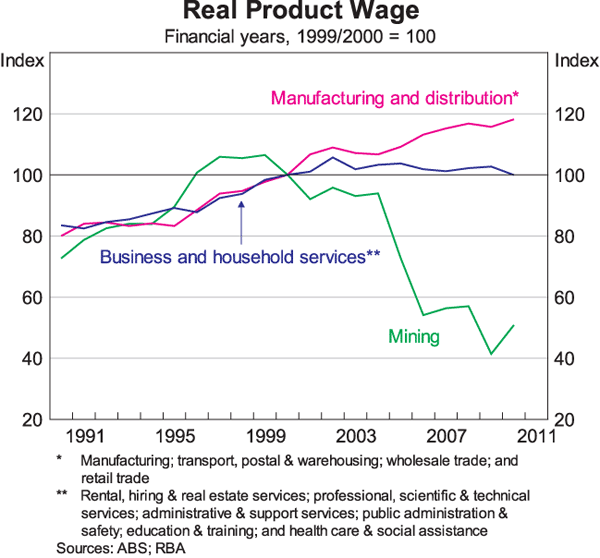
The overall picture emerging from the various relative prices that I have talked about is one of significant change. And when relative prices change, the allocation of resources within the economy also changes. And it is to this issue that I would now like to turn.
Structural Change
Before looking at recent developments, it is useful to take a slightly longer-term perspective. In an article published in the Reserve Bank's Bulletin in September last year, two of my colleagues looked at the current pace of structural change in the Australian economy compared with that in the past.[2] Their conclusion was that, with one notable exception, the rate of structural change is not especially high at present, although it is above average.
One reason that they draw this conclusion can be seen in a long-run graph of employment shares by industry (Graph 8). In the middle decades of the twentieth century there was a lot of structural change as the share of the workforce that was employed in the agricultural sector declined as more capital-intensive farming techniques became widespread. And then in the decades following the 1960s, as average incomes rose and tariff barriers came down, there was a very marked shift to employment in the services sector and away from manufacturing. Looking at this long-run record, it is obvious that structural change is something that is occurring all the time and, at least in terms of the labour market, the current rate of change is not unusual. A similar conclusion is reached when we look at changes in the composition of real output.
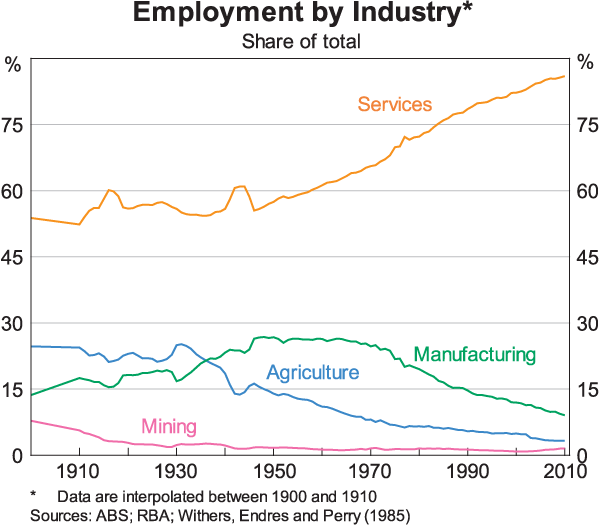
The notable exception to this general picture however is the very large change in the composition of investment in the economy. Over the past year, investment in the mining sector has accounted for almost 20 per cent of total investment in Australia (including both the private and public sectors), which is much higher than the average of earlier decades (Graph 9).
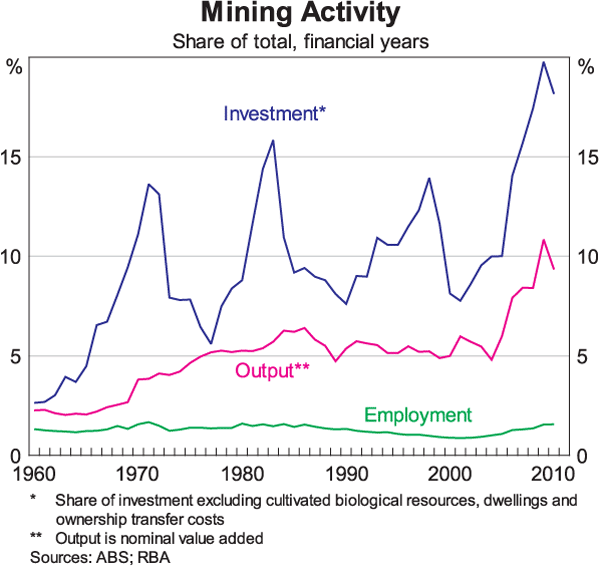
Looking forward, the latest data from the Australian Bureau of Statistics on firms' investment plans suggest that further very large increases in mining investment are in prospect (Graph 10). Taken literally, these data imply an increase in investment spending in the mining sector of over 50 per cent in 2011/12, from an already elevated level. The projected increases are particularly large in the gas and the iron ore sectors. If they were to occur, it would mean that the mining sector would account for over one quarter of all investment spending in Australia next financial year. This would be a remarkable change over a short period of time.
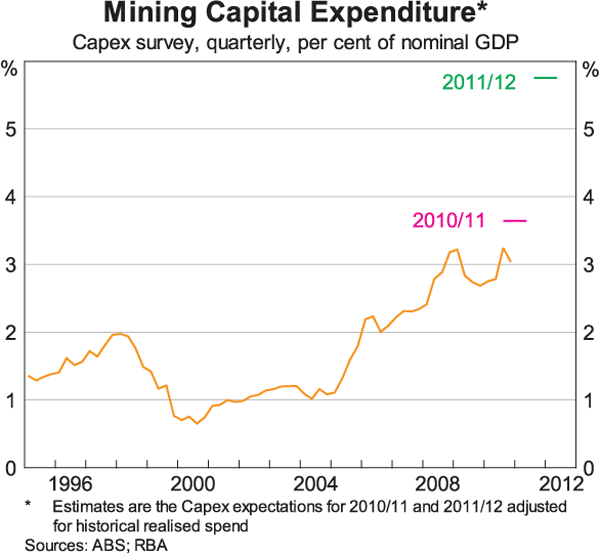
The high price of resources is also leading to very strong employment growth in the mining sector, with total employment in the sector up by around 20 per cent in 2010. But while this is very fast growth, it is important to remember that the sector still only directly accounts for less than 2 per cent of the overall workforce in Australia.
The main effects on employment of the resources boom are being felt elsewhere, particularly in the services sector where the vast bulk of Australians work. These indirect effects on employment from the resources boom arise through two main channels: one operating through a demand effect as investment ramps up, and the other through an income effect.
In terms of demand, the improved outlook for resource-sector investment has increased demand for a whole range of ancillary professional services. These include engineers, project managers, equipment lessors, lawyers, accountants, recruiters and IT specialists. As a result, employment in a number of these business services has grown strongly over recent years (Graph 11). In terms of the income effect, the higher prices we are receiving for our exports has delivered a tangible increase in national income. Over time, a substantial part of this will get spent. Right at the moment, spending on goods is relatively subdued, but with the population and aggregate incomes growing strongly, the demand for a range of services by households has also been growing strongly. As a result, employment growth in these areas has been robust.
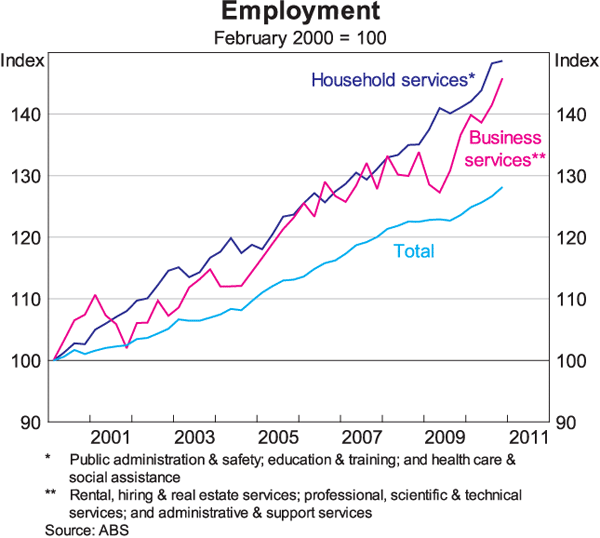
In contrast to this relatively positive picture in a number of industries, the changes in relative prices that are occurring are contributing to subdued conditions in some other industries.
One very clear example is domestic tourism. Since the mid 2000s, the total number of nights that Australians spend away from home in Australia has fallen by around 12 per cent, despite the population increasing by 10 per cent. The high value of the Australian dollar has lowered the relative price of overseas travel and Australians have responded by travelling abroad in ever increasing numbers. Conversely, as Australia has become a more expensive destination, growth in overseas arrivals has slowed noticeably (Graph 12). Given these trends, it is not surprising that the tourist industry's share of total employment has fallen over the past decade.
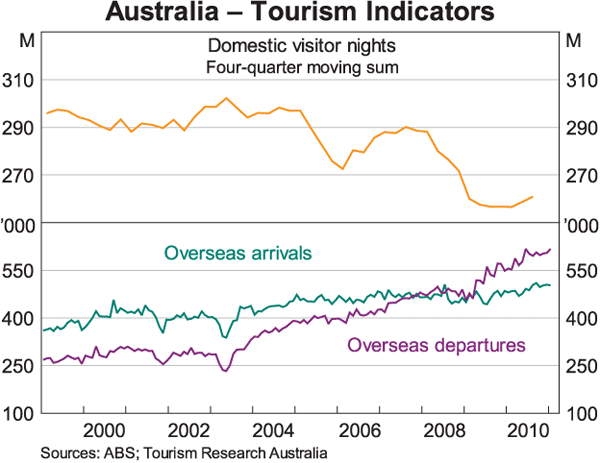
Another area where the effects of the changes in relative prices are apparent is in the composition of Australia's exports (Graph 13). During the 1990s, exports of manufactured goods and services grew strongly, at an annual rate of around 10 per cent. Growth then slowed in the early 2000s and it has been particularly weak over recent years. This weakness has been quite broad based, with exports of machinery and equipment, beverages and transport services all falling over the past three years. While there are a range of factors that account for this, an important one is the higher exchange rate which has increased the price of domestically produced goods relative to world prices. As a result, in a number of the affected sectors, employment growth has been relatively slow. Conditions have also been subdued recently in the retail and wholesale sectors, largely reflecting consumers' more cautious approach to spending.
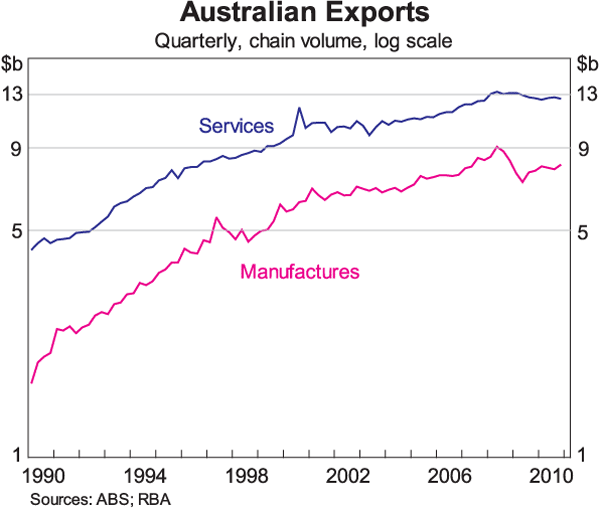
These various shifts in the economy are occurring at a time where there is little overall spare capacity. This is quite different to the situation prevailing over most of the past 40 years. At times when there is a lot of spare capacity, all sectors can grow quite quickly without the overall economy butting up against capacity constraints. But this is not the situation we currently find ourselves in. Our favourable starting point means that faster-than-trend growth in some parts of the economy will inevitably be associated with slower-than-trend growth in other parts of the economy. And the movement in relative prices will be one of the factors that help determine which sectors grow more quickly than average, and which sectors grow more slowly than average.
The challenge we face is how best to accommodate these changes, and to capture the considerable benefits that they can bring, while minimizing the costs that can arise when the structure of the economy is changing. This is no easy task. But it is surely a better challenge to face than those confronting most other advanced economies. The most important contribution the Reserve Bank can make to this task is to keep inflation low and stable, so that firms can respond to the shift in relative prices without their decisions being distorted by concerns about inflation in the general level of prices. The inflation targeting regime that we have had for nearly two decades provides the right framework to do this.
Finally, in thinking about the implications of the recent changes in relative prices an important consideration is how persistent they are likely to be. There would seem to be little benefit in changing the structure of the economy to reflect the new relative prices, only for the old set of relative prices to reassert themselves quite quickly. As the Governor noted in a speech a couple of weeks ago, we cannot be sure how long the current boom in the terms of trade will last. However, given that it is being driven by structural changes in the global economy, it is likely that commodity prices will be above their average over recent decades for some time yet. If this is the case, Australia will do very well. History, however, does suggest caution and we cannot be sure what the future will hold. The best way of dealing with this uncertainty is to make sure that the economy retains its flexibility to deal with whatever set of relative prices the global economy delivers us.
Endnotes
‘Manufactured goods’ here refers to clothing, footwear, furniture & floor coverings, motor vehicles, audio, visual and computing and similar items. [1]
See Connolly and Lewis (2010), ‘Structural Change in the Australian Economy’, RBA Bulletin, September, pp 1–5. [2]